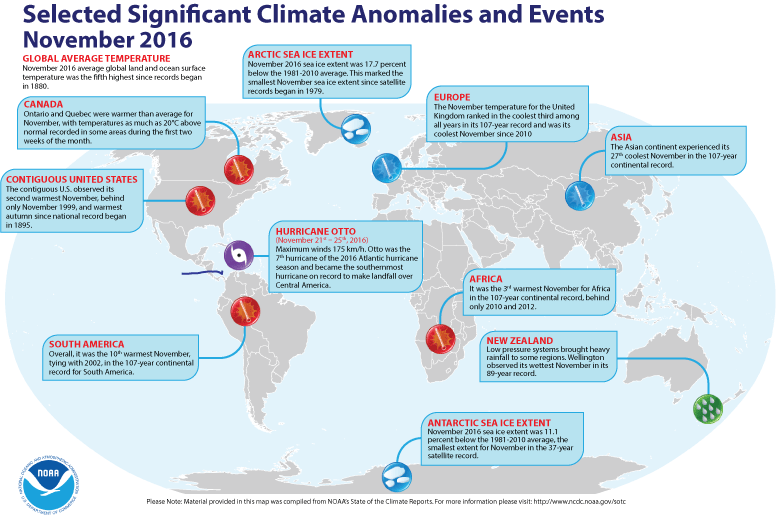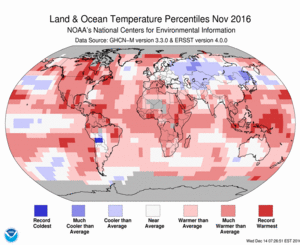Monthly Report Summary Information
The Monthly Report Summary Information is a synopsis of the collection of national and global summaries released each month.
Global Summary Information - November 2016
See Full Report
Note: With this report and data release, the National Centers for Environmental Information is transitioning to improved versions of its global land (GHCN-M version 3.3.0) and ocean (ERSST version 4.0.0) datasets. Please note that anomalies and ranks reflect the historical record according to these updated versions. Historical months and years may differ from what was reported in previous reports. For more, please visit the associated FAQ and supplemental information.
November is fifth warmest on record for the globe
With one month left, 2016 on pace to be record warm
Global highlights: November 2016
- The November temperature across global land and ocean surfaces was 1.31°F above the 20th century average of 55.2°F. This was the fifth highest for November in the 1880–2016 record, 0.41°F cooler than the record warmth of November 2015 when El Niño conditions were strong.
- The November globally averaged land surface temperature was 1.71°F above the 20th century average of 42.6°F. This value was the 12th highest November land global temperature in the 1880–2016 record.
- The November globally averaged sea surface temperature was 1.17°F above the 20th century monthly average of 60.4°F. This value was the second highest global ocean temperature for November in the 1880–2016 record, 0.34°F lower than the record warmth of November 2015.
- Snow cover across the Northern Hemisphere was 1.15 million square miles (8.7 percent) above the 1981–2010 average. This was the fourth largest snow cover extent of the record, which dates to 1966. North American snow cover extent was slightly below average while the Eurasian snow cover extent was the second largest on record.
- The average Arctic sea ice extent for November 2016 was 750,000 square miles (17.7 percent) below the 1981–2010 average, according to analysis by the National Snow and Ice Data Center using data from NOAA and NASA. This was the smallest November extent since records began in 1979. Sea ice growth was abnormally slow during the first and third weeks of November. Daily sea ice extent values were record low throughout the month.
- Antarctic sea ice extent during November 2016 was 700,000 square miles (11.1 percent) below the 1981–2010 average. This was the smallest Antarctic sea ice extent on record for November.
Global highlights: Seasonal (September–November 2016)
- The September–November temperature across global land and ocean surfaces was 1.39°F above the 20th century average of 57.1°F. This was the second highest for September–November in the 1880–2016 record, 0.32°F cooler than the record warmth of 2015.
- The September–November globally averaged land surface temperature was 1.75°F above the 20th century average of 48.3°F. This was the eighth highest for September–November in the 1880–2016 record.
- The September–November globally averaged sea surface temperature was 1.37°F above the 20th century average of 60.7°F. This was the second highest for September–November in the 1880–2016, 0.26°F cooler than the record warmth of 2016.
Global highlights: Year-to-date (January–November 2016)
- The year-to-date temperature across global land and ocean surfaces was 1.69°F above the 20th century average of 57.2°F. This was the highest for January–November in the 1880–2016 record, surpassing the previous record set in 2015 by 0.13°F.
- The year-to-date globally averaged land surface temperature was 2.57°F above the 20th century average. This was the highest for January–November in the 1880–2016 record, exceeding the previous record of 2015 by 0.28°F.
- The year-to-date globally averaged sea surface temperature was 1.37°F above the 20th century average. This was the highest for January–November in the 1880–2016, surpassing the previous record of 2015 by 0.05°F.
For extended analysis of global temperature and precipitation patterns, please see our full November report.
 NOAA's National Centers for Environmental Information
NOAA's National Centers for Environmental Information

